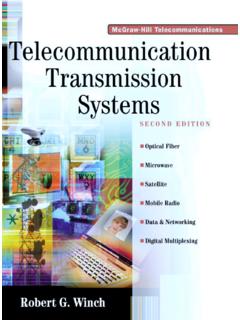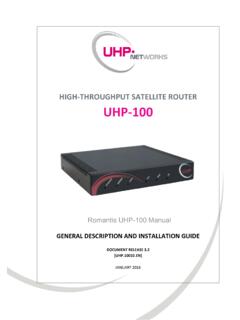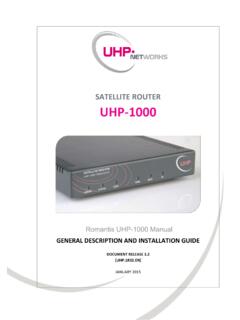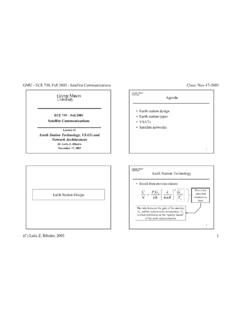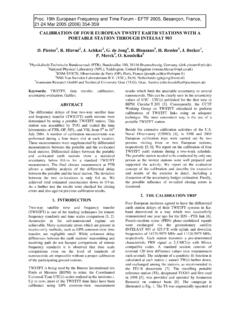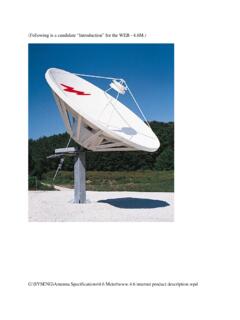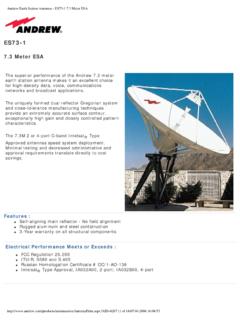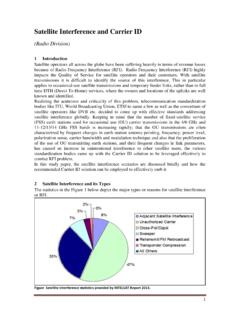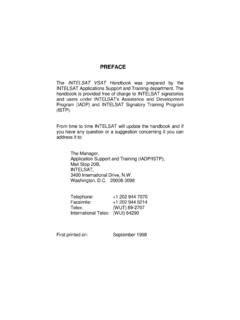Transcription of SATELLITE MODEM SCPC - Global Telesat
1 SATELLITE MODEM SCPC USER MANUAL SOFTWARE RELEASE [ ] JANUARY 2015 UHP SCPC MODEM USER MANUAL, ROMANTIS 2015 2 CONTENT ACRONYMS AND ABBREVIATIONS .. 5 INTRODUCTION .. 7 Required Qualifications .. 7 Document Version and Applicability .. 7 Copyright .. 7 1. GETTING STARTED .. 8 Measurement Equipment, Tools and Accessories .. 8 Required Information .. 8 WEB-Interface .. 9 2. CONFIGURATION .. 11 Configuring IP Address .. 11 Configuring IP Address using Telnet Access .. 12 Site Setup .. 12 Profiles .. 13 SCPC MODEM Profile .. 14 Receive and Transmit Configuration .. 15 Modulator Settings .. 15 TLC Settings .. 16 Adaptive Modulation and Coding .. 17 Routing .. 17 Redundancy .. 19 Redundancy Configuration .. 20 Redundancy Status Monitoring .. 22 3. SCRIPT-BASED CONFIGURATION .. 24 4. CONFIGURATION USING OPT FILE .. 26 Save Configuration as a Binary File .. 26 Binary File Configuration Load .. 26 5. POINTING TO SATELLITE .
2 28 Pointing with Use of WEB-Interface .. 29 Cross Polarization Test .. 30 Preparation for Measurement .. 30 Transmitter 1dB Compression Point Setting .. 32 6. COMMUNICATIONS ON THE MOVE (COTM) .. 33 OpenAMIP Protocol .. 33 COTM with use of SNMP .. 34 UHP SCPC MODEM USER MANUAL, ROMANTIS 2015 3 Automatic Beam Switching .. 34 Interaction with Mobile Antenna Controller .. 36 COTM working principles .. 37 7. OPERATION .. 38 Status Bar Statistics .. 38 Control Panel Statistics .. 38 Menu of Commands Statistics .. 39 Troubleshooting .. 39 Fault Identification .. 40 Fault Fixing .. 40 Support Information .. 40 Example of SCPC Fault Fixing .. 41 Monitoring Demodulator 41 Monitoring Modulator Status.. 42 8. ROUTER FIRMWARE .. 43 SW Memory Banks .. 43 Configuration of Memory Banks .. 44 Installing New SW .. 44 SW Installation via WEB-Interface .. 44 SW Installation Applying Console Connection .. 45 Installed Licenses (Keys) Data.
3 45 FIGURES Figure 1 Structure of UHP Manuals .. 7 Figure 2 Example SCPC channel 9 Figure 3 UHP WEB interface .. 10 Figure 4 Assigning new IP address .. 11 Figure 5 UHP routing table .. 11 Figure 6 General configuration screen .. 12 Figure 7 LNB LO labeling .. 13 Figure 8 BUC LO labeling .. 13 Figure 9 Profiles .. 14 Figure 10 Profile 14 Figure 11 Transmit and Receive Configuration .. 15 Figure 12 Management of the modulator .. 15 Figure 13 TLC Security Settings for station -1 .. 16 Figure 14 TLC Security Settings for station -2 .. 16 Figure 15 Transmission Level Control configuration .. 16 Figure 16 ACM settings of the station -1 .. 17 Figure 17 ACM settings of the station -2 .. 17 UHP SCPC MODEM USER MANUAL, ROMANTIS 2015 4 Figure 18 Configuration of IP route .. 18 Figure 19 Configuration of additional static IP route .. 18 Figure 20 Routing table of station -1 .. 19 Figure 21 Routing table of station -2 .. 19 Figure 22 1:1 redundant router connection diagram.
4 20 Figure 23 Assign additional IP address on main router .. 21 Figure 24 Assign additional IP address on backup router.. 21 Figure 25 Redundancy settings for main router .. 21 Figure 26 Redundancy settings for backup router .. 21 Figure 27 Additional IP address on backup router .. 22 Figure 28 Redundancy status .. 23 Figure 29 Configuration of TFTP server .. 26 Figure 30 Pointing of parabolic offset antenna .. 28 Figure 31 Configuring demodulator settings .. 29 Figure 32 Pointing monitor .. 29 Figure 33 Create a CrossPol profile .. 30 Figure 34 Configure CrossPol profile .. 30 Figure 35 Manual start of CrossPol test .. 31 Figure 36 Management of unmodulated carrier .. 31 Figure 37 COTM station structure .. 33 Figure 38 Beam coverage editor .. 34 Figure 39 Definition of the coverage .. 35 Figure 40 COTM configurator .. 36 Figure 41 Configuration and permission using SNMP for COTM .. 37 Figure 42 Status bar statistics .. 38 Figure 43 Control panel statistics .. 39 Figure 44 UHP demodulator statistics and configuration.
5 41 Figure 45 UHP demodulator statistics and configuration .. 42 Figure 46 UHP Modulator statistics and configuration.. 42 Figure 48 UHP router flash memory content .. 43 Figure 49 Loading and storage of UHP router configuration .. 44 Figure 50 Key information for UHP router .. 45 UHP SCPC MODEM USER MANUAL, ROMANTIS 2015 5 ACRONYMS AND ABBREVIATIONS NAME DESCRIPTION 16 APSK 16 Amplitude and Phase-shift keying or Asymmetric Phase-shift keying, (APSK), is a digital modulation scheme that conveys data by changing, or modulating, both the amplitude and the phase of a reference signal (the carrier wave). 32 APSK 32 Amplitude and Phase-shift keying or Asymmetric Phase-shift keying, (APSK), is a digital modulation scheme that conveys data by changing, or modulating, both the amplitude and the phase of a reference signal (the carrier wave). 8 PSK 8 Phase-shift keying (8 PSK) is a digital modulation scheme that conveys data by changing, or modulating, the phase of a reference signal (the carrier wave).
6 AGC Automatic Gain Control. BCH BCH code is a multilevel cyclic variable-length digital error-correcting code used for correcting multiple random error patterns. BCH codes may also be used with multilevel phase-shift keying whenever the number of levels is a prime number or a power of a prime number. BUC Block Up-Converter (BUC) is used in the transmission (uplink) of SATELLITE signals. It converts a band (or "block") of frequencies from a lower frequency to a higher frequency. Bandwidth Bandwidth is the difference between the upper and lower frequencies in a continuous set of frequencies. C/N Carrier-to-noise ratio, often written as CNR or C/N, is the signal-to-noise ratio (SNR) of a modulated signal. Carrier Carrier is a waveform that is modulated with an input signal for the purpose of conveying information. CCM Constant coding and modulation. DVB-S2 mode when MODCOD is not changed during channel operation. COTM Communication on the move CRTP Compressing IP/UDP/RTP Headers for Low-Speed Serial Links.
7 DAMA Demand Assigned Multiple Access. Channel establishment on demand. Data transmission Data transmission. Data rate Data (bit) rate is the number of bits that are conveyed or processed per unit of time. DSCP Differentiated Services Code Point (DSCP) is a 6-bit field in the header of IP packets for packet classification purposes. DSCP replaces the outdated IP precedence, a 3-bit field in the Type of Service byte of the IP header originally used to classify and prioritize types of traffic DVB Digital Video Broadcasting (DVB) is a suite of internationally accepted open standards for digital television. ES earth station Eb/No Eb/No (the energy per bit to noise power spectral density ratio) is a normalized signal-to-noise ratio (SNR) measure, also known as the SNR per bit . EIRP Effective Isotropically Radiated Power ETSI The European Telecommunications standards Institute (ETSI). FEC Forward error correction (FEC) is a system of error control for data transmission, whereby the sender adds redundant data to its messages, also known as an error-correction code.
8 Frame Digital data transmission unit (consequence of packets) of fixed length and periodicity. Hard priority Method of transmission queues handling when packets from lower priority queue are not transmitted until all packets from higher priority queue are transmitted. HTTP Hypertext Transfer Protocol (HTTP) is an application-level protocol for distributed, collaborative, hypermedia information systems. HUB Central station of SATELLITE network that is managing all the terminals and resources. HW Hardware. ICMP The Internet Control Message Protocol (ICMP) is used by networked devices to send error messages indicating, for instance, that a requested service is not available or that a host or router could not be reached. IESS intelsat earth station standards IF Intermediate Frequency is a frequency to which a carrier frequency is shifted as an intermediate step in transmission or reception. IFL Connection from the indoor equipment ( MODEM /router) to the outdoor equipment at the antenna normally involves two inter-facility (IFL) cables.
9 IGMP The Internet Group Management Protocol (IGMP) is a communications protocol used by hosts and adjacent routers on IP networks to establish multicast group memberships. IP IP is the usual abbreviation for Internet Protocol. LDPC Low-density parity-check (LDPC) code is a linear error correcting code, a method of transmitting a message over a noisy transmission channel, and is constructed using a sparse bipartite graph. LNB Low-noise block converter is the receiving converter installed at SATELLITE antenna. Local oscillator Oscillator built into RF block converter (BUC or LNB) for the purpose of converting RF-IF frequencies. Value of LO is usually written on block enclosure or in datasheet. Long frames DVB-S2 frames 64800 bits long (including FEC). Require slightly lower C/N than short frames. MCPC Multiple channels per carrier. All TDM carriers generated by UHP can be treated as MCPC. Even if they are called SCPC. MODCOD Modulation and coding mode. NMS Network Management System UHP SCPC MODEM USER MANUAL, ROMANTIS 2015 6 ODU Outdoor Unit part of earth station installed outside.
10 QPSK 4 Phase-shift keying (QPSK) is a digital modulation scheme that conveys data by changing, or modulating, the phase of a reference signal (the carrier wave). RF Radio frequency RF level Absolute RF level of entire signal (carrier + adjacent carriers) expressed in dBm. RSV Reed Solomon error correction is an error-correcting code that works by oversampling a polynomial constructed from the data. SATELLITE router SATELLITE router is a networking device, commonly specialized hardware that forwards data packets between networks via SATELLITE . SCPC Single Channel Per Carrier Short frames DVB-S2 frames 16200 bits long (including FEC). Advisable to use at lower symbol rates. Produce less delay than Long frames. SNMP Simple Network Management Protocol SNR Signal-to-noise ratio is an electrical engineering measurement defined as the ratio of a signal power to the noise power corrupting the signal. SNTP Simple Network Time Protocol (SNTP) is a protocol and software implementation for synchronizing the clocks of computer systems over packet-switched, variable-latency data networks.
